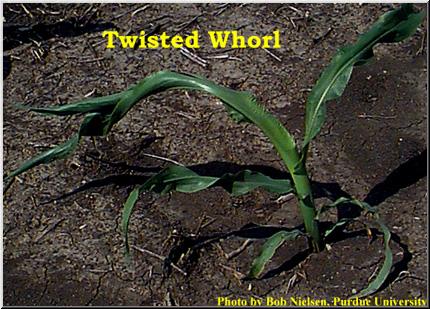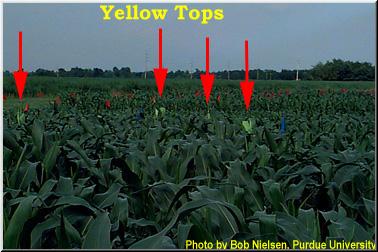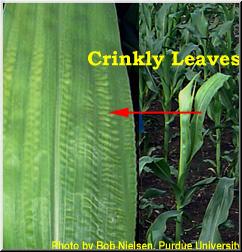Rapid Growth Causes Twisted
Whorls in Corn
R.L. (Bob) Nielsen ,
Agronomy Department ,
Purdue University, West Lafayette, IN
47907-1150
Internet address: rnielsen@purdue.edu
- Unusual twisted growth of whorls noted in some fields.
- Caused by sudden return to good growing conditions.
- Yield effects are minimal, if any.
Some early-planted corn fields are showing symptoms of unusual twisted
growth in recent days. The whorls of affected plants are tightly twisted, often
bent over severely, and do not unfurl on a timely basis. One's natural
instincts would blame the twisted growth on herbicide injury. But, in most
cases, the cause is something entirely different. In fact, we saw identical
symptoms in corn fields in 1995.
 The problem
often occurs following a sudden return to optimum growing conditions preceded
by a period of poor growing conditions. This year, what little corn that was
planted in April and early May has struggled through a cooler than normal and
frequently cloudy May and early June. Sunshine and warmer temperatures finally
returned on about June 12. Early-planted corn has responded by finally
beginning to grow rapidly.
The problem
often occurs following a sudden return to optimum growing conditions preceded
by a period of poor growing conditions. This year, what little corn that was
planted in April and early May has struggled through a cooler than normal and
frequently cloudy May and early June. Sunshine and warmer temperatures finally
returned on about June 12. Early-planted corn has responded by finally
beginning to grow rapidly.
Certain hybrids react to such a change in growing conditions by
basically going 'bonkers'. The upper whorls of the plants don't unfurl
properly. Younger leaves deeper in the whorl continue to grow rapidly, but are
unable to emerge from the unfurled upper leaves. The now tightly twisted whorl
then bends and kinks from the pressure exerted from the younger leaves'
continued growth. The growth stage where this phenomenon seems to occur is
around five to six visible leaf collars (about knee-high).
At the peak of the problem, the appearance of these plants is indeed
unsettling and one would think that the whorls would never unroll properly.
Given another week, though, the majority of the affected plants do unroll and
continue to grow normally. Yield effects from the period of twisted growth will
be minimal, if any.
 If you didn't notice the twisted growth to begin with,
you may notice the appearance of 'yellow tops' across the field after the
whorls unroll. The younger leaves that had been trapped inside the twisted
upper leaves emerge fairly yellow due to the fact that they had been shaded for
quite some time.
If you didn't notice the twisted growth to begin with,
you may notice the appearance of 'yellow tops' across the field after the
whorls unroll. The younger leaves that had been trapped inside the twisted
upper leaves emerge fairly yellow due to the fact that they had been shaded for
quite some time.
 In addition to being fairly yellow, the
leaves will exhibit a crinkly surface caused by their restricted expansion
inside the twisted whorl. Another day or two will green these up and the
problem will no longer be visible.
In addition to being fairly yellow, the
leaves will exhibit a crinkly surface caused by their restricted expansion
inside the twisted whorl. Another day or two will green these up and the
problem will no longer be visible.

For other information about corn, take a look at
the Corn Growers Guidebook on the World Wide Web at
http://www.agry.purdue.edu/ext/corn/
End of Document
 The problem
often occurs following a sudden return to optimum growing conditions preceded
by a period of poor growing conditions. This year, what little corn that was
planted in April and early May has struggled through a cooler than normal and
frequently cloudy May and early June. Sunshine and warmer temperatures finally
returned on about June 12. Early-planted corn has responded by finally
beginning to grow rapidly.
The problem
often occurs following a sudden return to optimum growing conditions preceded
by a period of poor growing conditions. This year, what little corn that was
planted in April and early May has struggled through a cooler than normal and
frequently cloudy May and early June. Sunshine and warmer temperatures finally
returned on about June 12. Early-planted corn has responded by finally
beginning to grow rapidly.  If you didn't notice the twisted growth to begin with,
you may notice the appearance of 'yellow tops' across the field after the
whorls unroll. The younger leaves that had been trapped inside the twisted
upper leaves emerge fairly yellow due to the fact that they had been shaded for
quite some time.
If you didn't notice the twisted growth to begin with,
you may notice the appearance of 'yellow tops' across the field after the
whorls unroll. The younger leaves that had been trapped inside the twisted
upper leaves emerge fairly yellow due to the fact that they had been shaded for
quite some time.  In addition to being fairly yellow, the
leaves will exhibit a crinkly surface caused by their restricted expansion
inside the twisted whorl. Another day or two will green these up and the
problem will no longer be visible.
In addition to being fairly yellow, the
leaves will exhibit a crinkly surface caused by their restricted expansion
inside the twisted whorl. Another day or two will green these up and the
problem will no longer be visible.